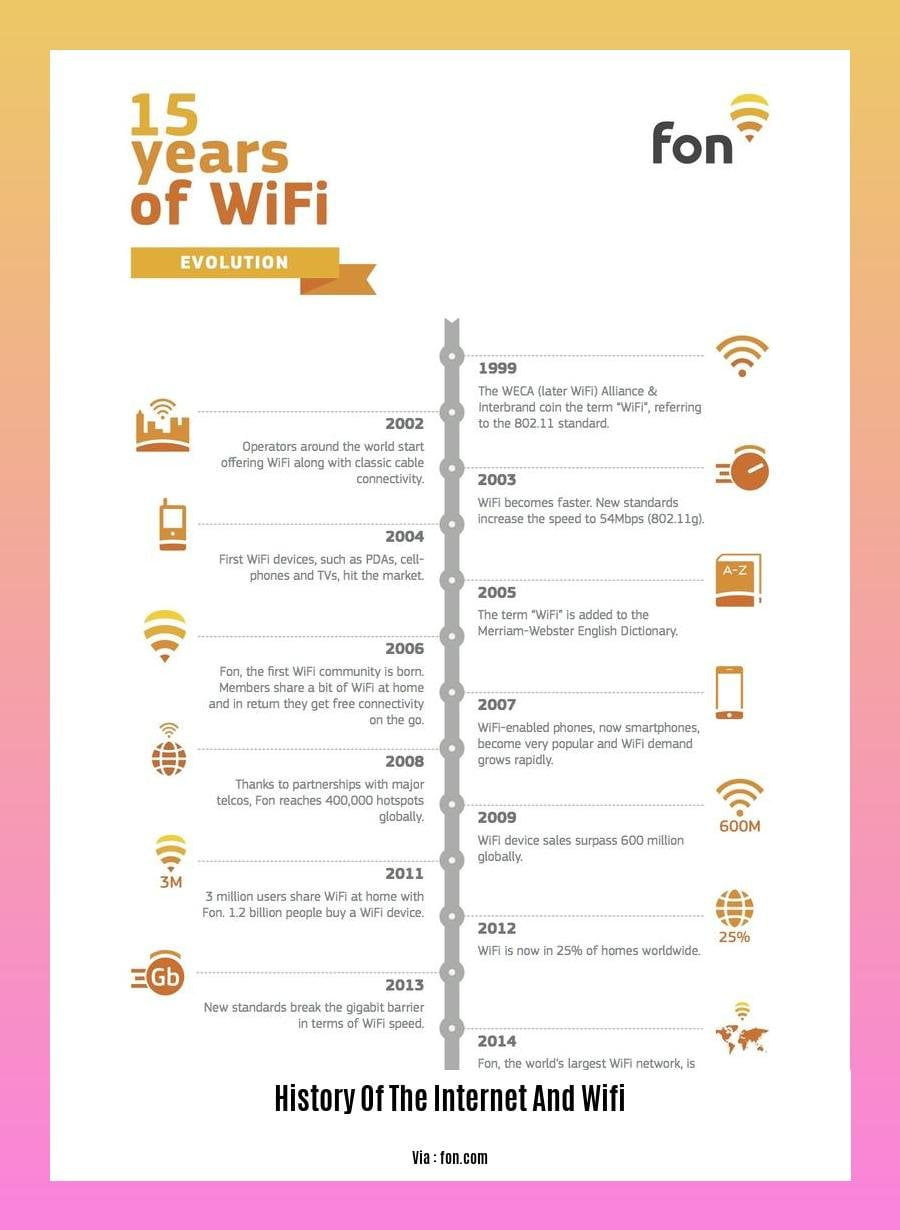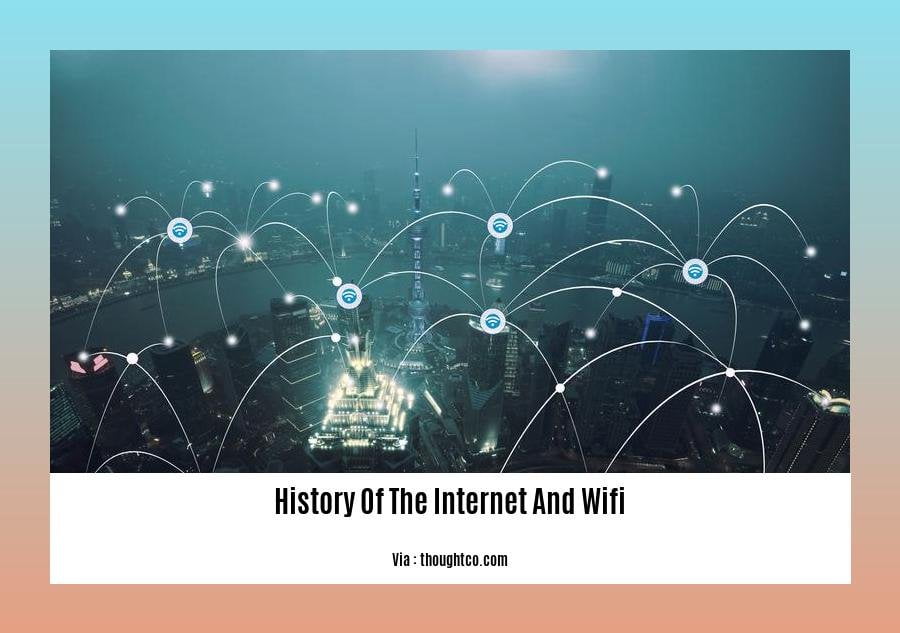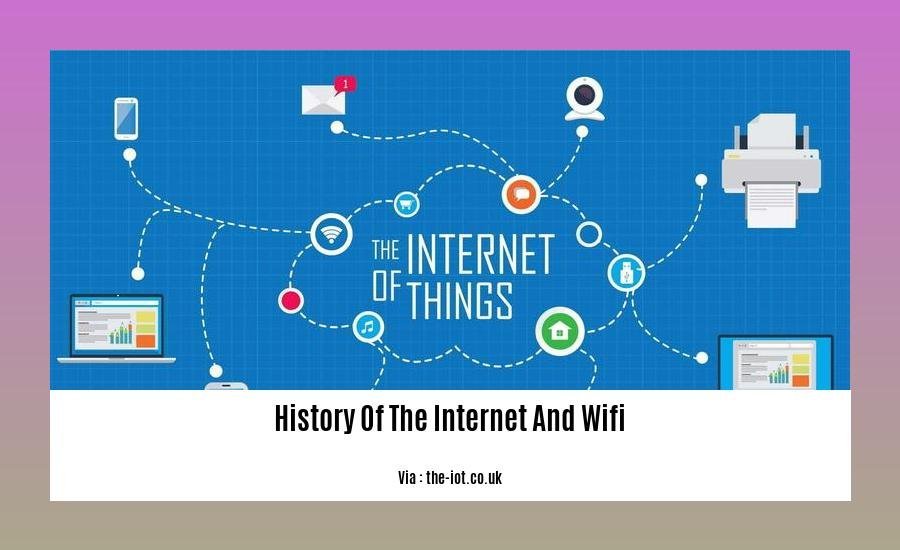Unraveling the Tapestry of Connectivity: [Tracing the Evolution: A Journey Through the History of the Internet and Wi-Fi], we embark on an epic voyage through time, exploring the transformative saga of the Internet and Wi-Fi. From the genesis of ARPANET and the advent of TCP/IP to the profound societal impact of the digital age, we delve into the intricate tapestry of innovation, exploring the milestones, challenges, and profound changes that have shaped our interconnected world.
Key Takeaways:
- Wi-Fi has evolved from infrared technology to IEEE 802 standards, enabling interoperability and broad adoption.
- Wi-Fi applications drive the market, with devices running these applications networking local area networks.
- Wi-Fi has revolutionized connectivity, transforming industries, businesses, and education.
- Wi-Fi has simplified and enhanced connectivity, creating a more interconnected world.
The History of the Internet and Wi-Fi

From humble beginnings to a global phenomenon, the history of the internet and Wi-Fi is a saga of innovation, collaboration, and relentless progress, forever altering how we communicate and perceive the world. Let’s delve into the captivating journey of these transformative technologies:
The Genesis: Forging Connections in a Digital Age
The history of the internet has its roots in the 1960s, when scientists and researchers envisioned a decentralized network that could withstand the challenges of nuclear war. This vision led to the creation of ARPANET, the precursor to the internet, developed by the U.S. Department of Defense.
Over the next decade, ARPANET grew and evolved, connecting universities, research institutions, and government agencies. In 1983, the Transmission Control Protocol and Internet Protocol (TCP/IP) emerged, establishing a common language for computers to communicate across networks. This pivotal moment marked the birth of the internet as we know it today.
The World Wide Web: Unleashing the Power of Connectivity
The history of Wi-Fi began in the late 1990s with the development of IEEE 802.11, the standard that underpins Wi-Fi technology. This ingenious innovation enabled wireless devices to connect to the internet without the need for physical cables, unlocking a new era of mobile connectivity.
As Wi-Fi evolved through generations (802.11a, 802.11b, 802.11g, and beyond), it brought exponential improvements in speed, range, and reliability. This technological advancement transformed homes, offices, and public spaces into wireless hotspots, providing seamless internet access to an ever-growing number of devices.
The Internet and Wi-Fi: A Catalyst for Global Transformation
The convergence of the internet and Wi-Fi has indelibly transformed our lives. The internet has revolutionized the way we communicate, access information, conduct business, and consume entertainment. It has created a global village, bridging distances and connecting people from all walks of life.
Wi-Fi has complemented the internet’s reach by providing wireless freedom. It has empowered us to stay connected on the go, fostering collaboration, productivity, and a seamless flow of information. The combination of these technologies has fueled innovation across industries, sectors, and societies.
Looking Forward: Embracing the Future of Connectivity
The history of the internet and Wi-Fi is one of continuous evolution, and the future holds even greater promise. The advent of 5G networks and the Internet of Things (IoT) is poised to further redefine our relationship with technology.
As we move forward, the internet and Wi-Fi will continue to evolve and integrate into every aspect of our lives. These technologies have the potential to enhance our productivity, improve our quality of life, and open up new frontiers of human endeavor.
Dive into the fascinating evolution of the internet and social media through the ages, unveiling their impact on our lives. History Of The Internet And Social Media
Travel back in time to explore the groundbreaking developments of the internet in the 2000s, witnessing the rise of social networking and the transformation of communication. History Of The Internet In The 2000s
Delve into the captivating history of internet access, tracing its humble beginnings to its widespread adoption, and discover how it revolutionized the way we connect and share information. History Of Internet Access
Embark on a journey through the comprehensive history of the internet, as told by Wikipedia, the world’s largest encyclopedia, and uncover the pivotal moments that shaped its evolution. History Of The Internet Wikipedia
In a nutshell, explore the remarkable journey of the internet, from its inception to its global reach, and witness how it has transformed the way we live, work, and connect. History Of The Internet In A Nutshell
Societal aspects[edit]

The advent of the internet and Wi-Fi technology has fundamentally transformed the fabric of societies worldwide. Their impact extends far beyond the realm of communication and information sharing, profoundly shaping our interactions, behaviors, and access to knowledge. Let’s delve into the societal aspects of these technologies:
Communication and Social Dynamics:
The internet and Wi-Fi have revolutionized communication, fostering global connectivity and reshaping social dynamics. Social media platforms, instant messaging, and video conferencing have redefined how we interact, fostering connections across vast distances and blurring geographical boundaries. These technologies have facilitated greater collaboration, strengthened community ties, and provided avenues for self-expression and activism.
The Democratization of Information:
The internet has democratized access to information, making vast amounts of knowledge instantly accessible to anyone with an internet connection. This has leveled the playing field in education, allowing individuals from all walks of life to pursue their learning interests. Moreover, it has empowered citizens to hold institutions accountable, fostering transparency and promoting civic engagement.
Economic Opportunities and Digital Divide:
The internet and Wi-Fi have opened up a plethora of economic opportunities, enabling e-commerce, remote work, and digital entrepreneurship. However, the digital divide persists, with disparities in internet access and digital literacy hindering equal participation in the digital economy. Addressing this divide is imperative for inclusive economic growth and social progress.
The Changing Nature of Work:
The proliferation of the internet and Wi-Fi has transformed the nature of work, enabling greater flexibility and remote work possibilities. This shift has implications for work-life balance, productivity, and the spatial organization of economic activities.
Privacy and Data Security Concerns:
The immense amount of personal data generated through internet use has raised concerns about privacy and data security. The collection, storage, and use of personal information pose significant risks, highlighting the need for strong data protection regulations and ethical considerations.
Key Takeaways:
The internet and Wi-Fi have revolutionized communication, enabling global connectivity and reshaping social dynamics.
Democratization of information through the internet has enhanced access to knowledge, empowering individuals and fostering civic engagement.
The digital divide poses a challenge to inclusive economic growth, highlighting the need to bridge the gap in internet access and digital literacy.
The internet and Wi-Fi have transformed the nature of work, enabling flexibility and remote work possibilities, impacting work-life balance and productivity.
Privacy and data security concerns associated with the internet and Wi-Fi underscore the importance of strong data protection regulations and ethical considerations.
Relevant URL Sources:
The Impact of the Internet on Society
The Digital Divide: A Challenge to Inclusive Economic Growth
2010–2019: Advancing Connectivity and Transforming Lives
The decade between 2010 and 2019 witnessed a surge in internet and Wi-Fi advancements, ushering in a new era of connectivity, convenience, and innovation. This decade marked a paradigm shift in how we communicate, access information, and conduct business.
The Rise of Mobile Internet and the Explosion of Apps
The proliferation of smartphones and tablets spurred the demand for mobile internet connectivity. The introduction of 4G LTE networks significantly boosted mobile internet speeds, allowing users to effortlessly stream videos, browse the web, and access online services on the go.
This surge in mobile internet usage was accompanied by an explosion of mobile applications. App stores became gateways to a vast universe of apps, catering to diverse needs and interests. From social media and messaging apps to productivity tools, gaming, and entertainment, the availability of apps revolutionized the way people used their mobile devices.
Wi-Fi’s Ubiquitous Presence and the Growth of IoT Devices
Wi-Fi networks became ubiquitous, blanketing homes, offices, public spaces, and even remote areas with wireless connectivity. The increasing affordability of Wi-Fi routers and the growing number of Wi-Fi-enabled devices made Wi-Fi the preferred mode of internet access.
The proliferation of Wi-Fi also fueled the growth of IoT (Internet of Things) devices. Smart home devices, wearables, and other IoT gadgets became an integral part of our daily lives, connecting to Wi-Fi networks to communicate with each other and the internet.
The Advent of Social Media and the Rise of Digital Communities
Social media platforms like Facebook, Twitter, and Instagram gained immense popularity, transforming the way people communicate and connect with each other. These platforms fostered the formation of online communities, enabling individuals to share their thoughts, experiences, and ideas with a global audience.
Social media also became a powerful tool for businesses and organizations to engage with their customers and build brand loyalty. It revolutionized marketing strategies, allowing brands to reach and interact with their target audiences in a more personalized and engaging manner.
The Era of Cloud Computing and Big Data Analytics
Cloud computing emerged as a dominant force, changing the way businesses store, manage, and process data. Cloud platforms such as Amazon Web Services (AWS), Microsoft Azure, and Google Cloud Platform (GCP) provided scalable and cost-efficient computing resources, enabling businesses to innovate and grow without the burden of maintaining their own infrastructure.
Hand in hand with cloud computing came the rise of big data analytics. The massive volumes of data generated by the internet, social media, and IoT devices fueled the need for advanced data analysis tools and techniques. Companies began to harness the power of big data to gain insights into customer behavior, improve operational efficiency, and make data-driven decisions.
Cybersecurity Concerns and the Need for Enhanced Security Measures
The increasing reliance on the internet and Wi-Fi brought cybersecurity concerns to the forefront. Cyberattacks, data breaches, and identity theft became common threats, prompting individuals and organizations to implement robust security measures to protect their data and digital assets.
Governments and regulatory bodies introduced stricter cybersecurity regulations and standards to ensure the protection of sensitive data. Cybersecurity became a critical component of business operations, with companies investing heavily in cybersecurity infrastructure and solutions to safeguard their networks and systems.
Key Takeaways:
The 2010s witnessed the rise of mobile internet and the explosion of mobile apps, transforming how people accessed information and consumed content.
Wi-Fi’s ubiquitous presence and the growth of IoT devices led to a more interconnected world, enabling the seamless exchange of data and communication between devices.
Social media platforms became powerful tools for communication, community building, and marketing, revolutionizing the way people connect and engage with each other.
Cloud computing and big data analytics emerged as key drivers of innovation, providing businesses with scalable computing resources and insights into customer behavior.
Cybersecurity concerns intensified, highlighting the need for enhanced security measures to protect data and digital assets from cyber threats.
Citation:
[1]
[2] #:~:text=The%20growth%20of%20the%20internet,access%20the%20internet%20from%20home
FAQ
Q1: What was the significance of the ARPANET in the development of the internet?
A1: The ARPANET, short for Advanced Research Projects Agency Network, played a pivotal role in the development of the internet. Established by the United States Department of Defense in the late 1960s, the ARPANET was initially designed as a network to connect research institutions and universities. It served as a testbed for various networking technologies and protocols, including TCP/IP, which later became the foundation of the internet.
Q2: How did the development of TCP/IP contribute to the growth of the internet?
A2: The development of the Transmission Control Protocol (TCP) and Internet Protocol (IP), collectively known as TCP/IP, was a major breakthrough in the evolution of the internet. TCP/IP is a suite of communication protocols that enabled different networks to communicate with each other, regardless of their underlying technologies. Its standardized approach to data transmission and addressing allowed various networks to connect and exchange information, thus facilitating the growth and interoperability of the internet.
Q3: What were the key societal impacts of the internet’s rapid expansion in the 2010-2019 decade?
A3: The rapid expansion of the internet in the 2010-2019 decade had profound societal impacts. It led to increased accessibility of information, transforming how people consumed news, conducted research, and pursued education. Social media platforms emerged as powerful tools for communication, enabling individuals to connect and share ideas on a global scale. E-commerce and online services became ubiquitous, revolutionizing shopping, banking, and entertainment. Moreover, the internet’s influence extended to politics, activism, and social movements, empowering individuals to organize and mobilize around various causes.
Q4: How did the dot-com bubble burst affect the internet’s evolution?
A4: The dot-com bubble burst in 2000 had a significant impact on the internet’s evolution. The speculative investment in internet-related companies during the late 1990s led to an unsustainable boom, which eventually resulted in a market correction. The bubble burst caused many dot-com companies to fail, leading to job losses and financial instability in the tech industry. However, it also brought a renewed focus on sustainable business models and long-term growth rather than short-term hype.
Q5: What are some of the ongoing challenges and opportunities in the internet’s development?
A5: The internet’s ongoing development presents both challenges and opportunities. Challenges include ensuring equitable access to the internet for all, addressing concerns related to data privacy and security, and mitigating the spread of misinformation and harmful content. Opportunities lie in harnessing the internet’s potential for innovation, enabling new technologies and applications, and fostering collaboration and knowledge sharing on a global scale. Additionally, the internet’s role in shaping society and governance continues to evolve, providing a platform for discourse, civic engagement, and the pursuit of a more connected and informed world.









